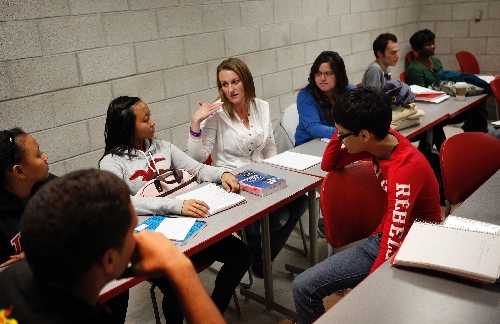Private gifts to Nevada’s universities make a difference for students



Hollie Taylor was at the end of her rope.
She’d been denied admittance to UNLV, which probably should not have been surprising considering she’d been out of school for 15 years, had two kids and worked two full-time jobs.
But Taylor simply would not accept that. She knew she was college material.
So she appealed the denial. One of the things she was told to do was get a letter of recommendation.
She had no idea whom she should ask. She’s a waitress at the Dragon Ridge Country Club in Henderson. She does not personally know the kind of people who have influence.
Then she thought of a man whom she often saw at work, the well-dressed guy who came to the country club with his wife all the time.
He seemed important, and they seemed to have a good relationship.
So, she asked him, right out of the blue, despite having no idea what he did for a living.
That guy turned out to be not only important, and a good reference, but the vice president for advancement at UNLV. He’s in charge of fundraising and the university’s public image.
Bill Boldt wrote her that letter. He said it’s part of the normal process for university administrators, to recruit people they think would be good students at UNLV.
Taylor was accepted.
Then she had to figure out how to pay for it. When you count books and course fees, it can cost more than $5,000 a year to attend UNLV.
Boldt had something in mind. He’d been working on getting the latest high-profile donation to the university, a multimillion-dollar gift from the estate of a recently deceased real estate developer.
The donation, intended to provide scholarships for people exactly like Taylor, came through. It’s not based entirely on academics, nor entirely on financial status.
With two full-time jobs, Taylor technically earns too much money to qualify as poor. And she has virtually no academic record to fall back on, so she wouldn’t qualify for most academic scholarships.
But she did qualify for this one. Boldt called her last week to tell her she’d be the first recipient of the Philip Cohen Scholarship.
"I can’t even put into words how much of a difference this is going to make," Taylor said moments after getting the news.
That’s exactly the point.
Private gifts to the university are dwarfed by taxpayer support, but they are not insignificant. They make a real difference.
In the past decade, UNLV has raised $313,728,000 in private contributions, according to the Council for Aid to Education’s annual Voluntary Support of Education survey. Last year, they were just under $30 million. For comparison, state general fund support to UNLV was $156 million last year.
It’s a similar story at the University of Nevada, Reno, which is smaller than the University of Nevada, Las Vegas but much older. In the past decade, private contributions to UNR have totaled $261,276,000, including $23 million last year. State general fund support to UNR was $144 million last year.
The private donations are used for everything from putting up new buildings to paying the salaries of selected professors to providing scholarships.
Private contributions to universities topped $28 billion nationwide in 2010, a slight increase over the year before. When inflation is taken into account, giving was 6 percent lower than in 2006, the high water mark.
Nevada’s universities have a similar record over the past several years, reaching record marks before the effects of the recession kicked in.
But the numbers appear to be rebounding.
The nation’s top fundraising university is Stanford, at roughly $600 million a year, followed closely by Harvard.
Those totals — and those of public universities such as the University of California, Los Angeles and the University of Michigan — dwarf the numbers at UNLV and UNR, but insiders say it is not fair to compare them.
The two Nevada universities have relatively small alumni pools, neither has been large for very long, and both are relatively small-time on the national scene.
"Donors go with winners," said big-time donor, education activist and media mogul Jim Rogers, a former state higher education system chancellor.
TOP PRIORITY
Neal Smatresk, UNLV’s president, said fundraising is one of the top priorities of any university president these days.
"These are challenging times, but we are also in the middle of one of the most philanthropic communities I’ve ever seen," said Smatresk, who was an administrator at universities in Texas and Hawaii before joining UNLV in 2007.
He called philanthropists the best friends any university can have. Especially one like UNLV, which was opened 54 years ago. Most of its donors did not graduate from UNLV but have chosen to give to the university because they live here.
"Most of the people adopted us out of their passion for higher education," he said. "I don’t want to sound corny, but there’s something really heartwarming about that."
He pointed to a recently completed capital campaign that raised more than $500 million overall. He said much of the money raised during that campaign was focused on improving the campus.
Though the details have not been worked out yet, both Smatresk and Boldt said a new capital campaign is in the making.
Smatresk said future fundraising will more likely be focused on improving the academic programs at the university. That would include scholarships, enhancing programs and creating funded faculty positions.
"I want to be able to offer great students very significant scholarships to come here," he said.
A recent example of that is a $12.6 million gift from the Engelstad Family Foundation, the largest active scholarship program in the university’s history.
Ralph Engelstad made his fortune as the owner of the Imperial Palace. His donations to higher education included $100 million for a hockey arena at the University of North Dakota, where he once played goalie.
His gift to UNLV established the Engelstad Scholars Program, which will eventually provide 100 endowed scholarships a year. Students with a 3.25 grade-point average or above are eligible. Recipients will have to complete 100 hours of community service.
Another example is a $15 million contribution from Ted and Doris Lee, who own the Eureka Casino in Las Vegas and the Eureka Casino Hotel in Mesquite.
The Lees’ donation will create scholarships, a visiting lecture series and rename the business school. But the bulk of it will go toward paying for 10 new endowed professorships.
Over time, the thinking goes, the business school will attract top faculty, which will attract top students, improving the entire university.
"We live here. We’re part of the community," Ted Lee said. "I think with added resources and focus that UNLV could make a big jump forward."
Lee, the son of a Chinese immigrant who preached the value of education, has degrees from Harvard and the University of California, Berkeley. He has given heavily to both schools but also gave to UNLV to establish the first endowed professorship at UNLV’s Boyd School of Law.
"Hopefully," he said, "this gift will spur people to make a difference."
NEVADA’S CHALLENGES
Though both UNLV’s and UNR’s annual fundraising totals have risen dramatically in the past decade, they both pale in comparison not only to the top universities in the country, but to many universities in the region.
The University of New Mexico took in almost three times as much in 2011 as UNLV. Oregon State more than doubled it. The University of Arizona more than tripled it.
The University of Oregon has one graduate — Nike co-founder Phil Knight — who has given more than $300 million to the university.
Is there something wrong in Nevada?
Not necessarily, said Rae Goldsmith, the vice president for advancement resources at the Council for Advancement and Support of Education, a national nonprofit umbrella group.
She said fundraising totals vary widely nationwide. Key factors include the university’s location, its age and the size of its alumni pool.
"It’s not uncommon for younger institutions to need more time to develop a strong fundraising base, a strong donor base," she said.
She also noted that there are very few Phil Knights anywhere in the world. Any university is fortunate to have such a donor.
Neither of Nevada’s universities has been large long enough to have produced large numbers of alumni, with each having tens of thousands.
John K. Carothers, the vice president for development at UNR and the president of its foundation, through which virtually all donations must go, said 38 percent of UNR’s alumni have graduated in the last decade.
That makes for a relatively young pool of potential donors. And young people, in general, have not yet made their fortunes.
In addition, UNR until the 1990s, was very small. It is still not large, with about 18,000 students enrolled this year. And Reno itself is no metropolis, with a population of about 420,000 in the metro area.
"We’re just not that big a place," Carothers said. Despite that, the university’s fundraising totals — the amount actually collected — went from $14 million in 2002 to $23 million last year.
Unlike UNR, UNLV is in a large metro area, nearly 2 million strong in Clark County.
Boldt, the UNLV vice president who helped the single mom get a scholarship, said the university’s fundraising totals have been improving, going from $17 million in 2002 to almost $30 million last year, despite the recession.
And officials at both universities noted that while they do not compare to national fundraising powerhouses like the University of Michigan or Harvard, they do match up with many regional rivals.
Private gifts closely track those at Colorado State University, Montana State University and Boise State University, for example.
BUILDING A REPUTATION
Like Lee, Engelstad and Knight, Rogers has donated millions to higher education, including at UNLV, though he won’t say how much he’s given overall.
Rogers is the owner of Sunbelt Broadcasting, which includes KSNV-TV, Channel 3 in Las Vegas. He received his law degree from the University of Arizona, and in 1999 that university renamed its law school the James E. Rogers College of Law after he made a large donation.
Rogers said that the better a university’s reputation gets, the more likely it is to attract donors — especially major donors.
"You don’t put $10 million into a start-up chemistry department," he said.
He noted that major public universities like UC Berkeley receive virtually no tax money because they have such high donor support, unlike Nevada’s two universities.
Those universities have major revenue-generating research programs, something UNLV and UNR have been striving to develop. University officials say it is difficult, however, when the formula the state uses to fund the higher education system rewards enrollment rather than research programs. There is a study under way to look at rewriting that formula. Regardless, it costs money to hire the kind of top faculty who tend to generate large research grants.
Rogers said he is pessimistic about Nevada’s chances of joining those elite public universities any time soon.
"It’s hard to compete when you are as far behind as UNLV and UNR are," he said.
Boldt and Smatresk noted, however, that they would not be considering launching a new capital campaign at UNLV unless they had reason to believe it would be successful.
Rogers said the reasons given for the two Nevada universities’ relatively low fundraising totals are valid — small donor bases and a short history — but that there are other reasons too.
He said neither university has been given enough state support to develop strong, revenue-generating research programs.
"The state didn’t have enough sense for the last 30 years to put in enough money so that by now, they’d have weaned themselves off state support," he said. "They’d be able to support themselves."
Contact reporter Richard Lake at rlake@reviewjournal.com or 702-383-0307.
BIG DONORSRecent large donations to UNLV
• $37 million in 2008 from the Greenspun family
• $17 million in 2009 from the Lincy Foundation
• $15 million in 2011 from Ted and Doris Lee
• $12.6 million in 2009 from the Engelstad Family Foundation
Source: UNLV


















